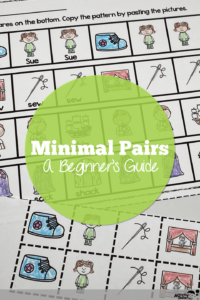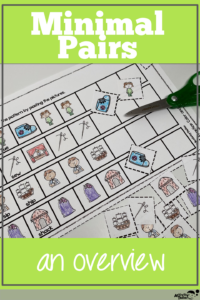The minimal pairs approach is a popular intervention for treating speech sound disorders. You might have heard your child’s SLP mention this, or maybe you are an SLP who is looking for a refresher about how to implement it with some of your students. Read on for an overview of the minimal pairs approach and learn when it’s most effective and how to implement it in therapy sessions!
What is the Minimal Pairs Approach?
The minimal pairs approach is one of the oldest interventions used to treat phonological disorders in speech. It’s formally referred to as “Minimal Oppositions”. This approach has been around since the 1980s.
An SLP often chooses this approach when a child presents with patterns in speech errors. Different word pairs are chosen as targets to help a child learn to differentiate sounds between words and learn correct phonological rules while speaking.
What is a Minimal Pair?
A minimal pair is a set of words that are different by only one sound or feature. These pairs are used to help create sounds that a child currently doesn’t use or reduce phonological processes found in their speech.
Examples:
- “Me” and “we”
- “Bat” and “bad”
- “Dough” and “go”
When is Minimal Pairs Most Effective?
Minimal pairs is often a great choice for therapy because it can be used for a variety of speech sound disorders like fronting, stopping, final consonant deletion, and more. It is best used for mild to moderate disorders.
Children with more severe speech sound disorders are better candidates for other phonological approaches such as the cycles approach or multiple oppositions.
Why Not an Articulation Approach?
For children with one or more phonological processes present, it’s helpful to choose a phonological approach to therapy, like minimal pairs, instead of using an articulation approach.
Articulation therapy targets the correct placement and production of sounds one at a time, but phonological interventions, like the minimal pairs approach, are able to focus on several sounds at once by targeting entire processes (aka sound patterns).
What to Start With When Using Minimal Pairs
It can sometimes feel confusing when trying to decide where to start in minimal pairs, especially for kids who present with more than one phonological process. There are a couple of considerations that are especially important and helpful to make this decision:
Non-Developmental Sound Patterns
Research supports targeting non-developmental phonological processes before typically developing ones in phonological intervention. If your child present with any unusual patterns in their speech, it’s likely that these will be a great starting point!
Examples:
- Backing
- Medial consonant deletion
Person-Centered Focus
It’s also helpful to have a person-centered focus when selecting the targets to address first.
Think about what sounds are present or missing from the child’s name and the names of important people in the child’s life. Also, consider topics of conversation that are most meaningful to the child and family. What patterns of sounds can help make these easier to communicate for the child?
Parents and SLPs alike want the quickest progress for all children, and person-centered goals are a way to optimize this potential! When choosing goals for therapy that the child and family truly connect with, the participation and carryover of skills increase immensely.
Implementing Minimal Pairs into Therapy
Now that you have a starting point, be confident as you implement minimal pairs into therapy sessions. Pre-made resources are a phenomenal way to keep things easy for you and fun for kids!
Speech Therapy Articulation and Minimal Pairs Resource
This resource includes three different activities for students to work on their speech sounds while practicing phonemic awareness and beginning letter sounds too! In these activities, you will find 10 minimal pair options with two variations for each.
Home activities are also included with this print & go resource!
Sliding Worksheets for Minimal Pairs SH/S
These worksheets provide a visual cue for students who have difficulty with the difference between /sh/ and /s/ sounds. Students actively participate in this activity by sliding their fingers across the visual to make the most impact during therapy practice.
It’s available digitally as BOOM cards and is great for homework too!
Pattern Worksheets for Minimal Pairs
These pattern worksheets are a fun, interactive way to keep little hands and young minds occupied while practicing minimal pairs in speech therapy. You will find ten different minimal pairs and various levels of patterns within this resource.
This is also a great option to send home for “color and say” homework that promotes the carryover of new skills and keeps families involved!
Whether you’re already familiar with the minimal pairs approach or brand new to the concept, remember that you are capable! You have the knowledge (& resources!) you need to help your child learn and grow!
References:
American Speech-Language-Hearing Association (n.d.) Speech Sound Disorders: Articulation and Phonology. (Practice Portal). www.asha.org/Practice-Portal/Clinical-Topics/Articulation-and-Phonology/.
You may also be interested in reading:
Selecting Targets for Articulation or Phonological Processing Therapy
How to Build a Play-Based Lesson Plan







